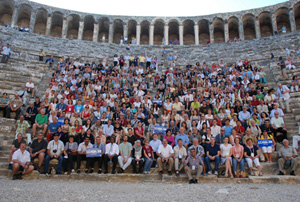 ECASIA'09, the 13th European Conference on Applications of Surface and Interface Analysis, took place from October 18 to 23, in Antalya. It was organized by Prof. Şefik Süzer, and his team, consisting of Emine Yiğit, Dr. Gülay Ertaş, and Dr. Emrah Özensoy, all from the Department of Chemistry. ECASIA'09, the 13th European Conference on Applications of Surface and Interface Analysis, took place from October 18 to 23, in Antalya. It was organized by Prof. Şefik Süzer, and his team, consisting of Emine Yiğit, Dr. Gülay Ertaş, and Dr. Emrah Özensoy, all from the Department of Chemistry.
This was the first time the biannual ECASIA conference has ever taken place outside geographic Europe. Normally the number of participants is around 400, but this year attendance rose to the record number of 605, with a large contingent of participants from Turkey. More than 30% of the participants were students, due to the sizable financial support of the sponsors and TÜBİTAK.
During ECASIA'09, 20 invited lecturers gave talks about the latest progress in their areas of expertise. Additionally, 211 oral and 407 poster presentations were delivered. More than 20 Turkish and foreign companies presented their state-of-the-art equipment for surface analysis as well as accessories.
The plenary lecture was delivered by Prof. Dr. Gabor A. Somorjai from the University of California at Berkeley, who is considered to be the father of the modern science of catalysis. His title was Molecular Studies of Surfaces under Reaction Conditions; Sum Frequency Generation Vibrational Spectroscopy, Scanning Tunneling Microscopy and Ambient Pressure X-ray Photoelectron Spectroscopy. Prof. Somorjai's lecture was truly outstanding, encapsulating and highlighting the past five decades and looking into the future almost as far. Prof. Dr. R. Stanley Williams from Hewlett-Packard Laboratories lectured on Memristor Devices based on Electroformed Titanium Dioxide. The existence of the memristor, short for "resistor with a memory," had been postulated in 1971, but was only fabricated by Williams' group last year. The memristor is the fourth basic element for constructing electronic devices, the other three being the resistor (R), the capacitor (C), and the inductor (I) (see details in Nature (Vol. 453, pp 80-83, 2008). Prof. Dr. Thomas J. McCarthy from the University of Massachusetts delivered a lecture on his research exploring the possibilities of changing the hydrophobic character of Teflon surfaces to hydrophilic, emphasizing the fact that any surface property can be imparted to any material by enforcing the necessary chemical and morphological changes.
The conference provided an excellent platform for an exchange between scientists from industry, academia, government and suppliers of equipment for surface analysis. Details about the conference can be seen on the conference web site: www.ecasia09.org

|







